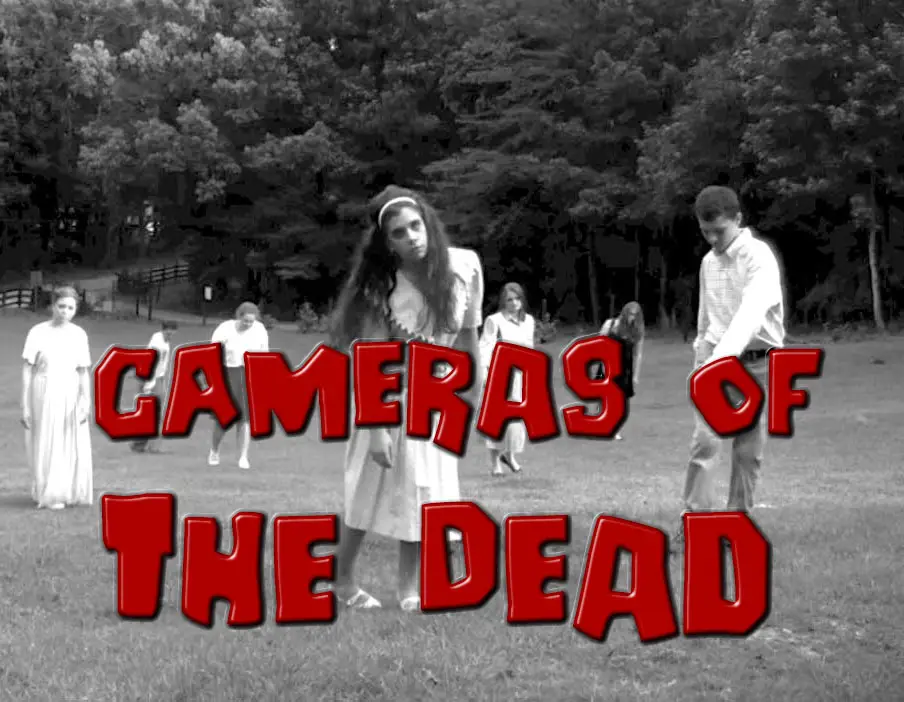 This review is part of the Cameras of the Dead series which I have been publishing every year on Halloween and “Halfway to” Halloween, featuring three cameras that I’ve wanted to review that either didn’t work, or was otherwise unable to shoot.
This review is part of the Cameras of the Dead series which I have been publishing every year on Halloween and “Halfway to” Halloween, featuring three cameras that I’ve wanted to review that either didn’t work, or was otherwise unable to shoot.
I am republishing each of those individual reviews this October in anticipation of this Halloween’s Cameras of the Dead post as a way to revisit the cameras of the past that allows them to be properly indexed on the site.
This is a Miranda dx-3 Single Lens Reflex camera made by the Miranda Camera Company and was in production from April 1975 through December 1976. It was Miranda’s first compact SLR and their first electronic SLR. Sadly, it was also the last camera designed by the company before they went bankrupt in late 1976. Although Miranda was already struggling when the camera went into production and the company had no experience building an electronic camera, the dx-3 was a surprisingly nice model with good ergonomics and a competitive feature set. Despite this, it was plagued with reliability problems, and Miranda’s poor reputation for quality doomed the camera before it ever hit store shelves.
Film Type: 135 (35mm)
Lens: 50mm f/1.8 Auto Miranda EC Coated 6-elements
Lens Mount: Miranda Bayonet and 44mm Screw Mount
Focus: 17 Inches to Infinity
Viewfinder: Fixed SLR Pentaprism
Shutter: Cloth Focal Plane
Speeds: B, 4 – 1/1000 seconds
Exposure Meter: TTL CdS cell w/ Viewfinder LED Readout
Battery: 4 x LR44/357 1.5v Batteries
Flash Mount: Hotshoe and PC X and FP sync port
Weight: 567 grams (body) / 790 grams (w/ lens)
Manual: http://www.cameramanuals.org/miranda_pdf/miranda_dx-3.pdf
My Thoughts
A Miranda in a “Cameras of the Dead” article? Of course there is!
Have you ever had that experience, perhaps when you were younger, of a special girl or boy that you liked, but he or she didn’t feel the same way about you? Well that about sums up my relationship with this brand of cameras. I have or have owned at least 10 Mirandas, and with the exception of one, they all don’t work, or in some way break WHILE I’m using them.

If you ask anyone who was active in photography in the 60s or 70s, they’ll likely tell you stories of how Mirandas had a poor reputation for quality, and if that was true when these things were new, imagine what half a century of age does to them. Making matters worse, Miranda’s already questionable quality control got worse near the end of the company’s existence, so if things were bad during their “glory days” imagine what it might be like to try and use their very last model.
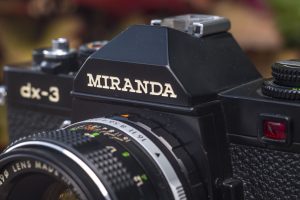
I present to you Miranda’s very last model, the dx-3. Miranda really wanted to compete with professional cameras like the Nikon F and release a model with similar features, but for a lesser cost. Every Miranda prior to the dx-3 had interchangeable viewfinders, dual bayonet/screw lens mounts, in body TTL metering, and came in a large and heavy all metal body.
By 1973, Miranda realized the writing was on the wall, and their previous models were big, heavy, and expensive to build. As a last ditch effort to modernize their cameras and use cost effective electronics, they started working on an all new, compact SLR with an electronic shutter, and a fixed pentaprism viewfinder.

Released in 1975, the all new dx-3 was available in black or chrome, and amazingly, was a nice looking camera with a competitive feature set, at least on paper. Perhaps it was Miranda’s already poor reputation, or the massive success of similar models by Olympus, Minolta, Pentax, and pretty much every other Japanese camera maker, but the dx-3 didn’t sell well. It was the final nail in the coffin for the company as they would go out of business less than 2 years after the model’s release.
The following three pages are from a Miranda dealer sales catalog, meant to give details of the models in their line up. On paper, the dx-3 really seemed to check all the right boxes of a mid 70s SLR.
Handling the Miranda dx-3 is surprisingly “not-Miranda-like”. The camera is nearly the same size as a Nikon FE and weighs only 30 grams less (567g vs 597g). The controls are all comfortably located, and even the shutter release is on the top plate where it appeared on nearly every other 1970s SLR.
The viewfinder is large and bright and features a really neat microprism focusing aide that they call the “Quadrascopic Image System” or QIS for short. According to the dx-3’s user manual, this system splits up any horizontal or vertical line in four (up/down and left/right) directions, hence the word “Quadrascopic” name. Now, many other SLRs have had microprism focus aides without such a goofy sounding name, so this was something I was looking forward to testing out myself.
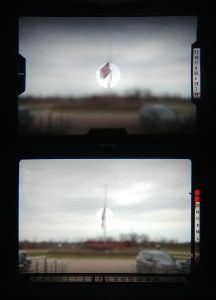
I am not going to pretend I fully understand how microprisms work, but the one in the dx-3 is different from any other I’ve seen. Click on the image to the right to get a full screen view of how it compares to a Canon EF. I show the same scene out of focus on both cameras. I used the Canon EF because it has what I consider to be a “normal” microprism. Look at the center of the flag pole on the Canon EF (bottom), the microprism “breaks apart” the pole to indicate that it is out of focus, but the pole itself is still lined up with the rest of the image outside of the microprism. Now look at the Miranda dx-3 (top) and you’ll see the microprism still breaks apart the pole, but the center of the pole is shifted to the side. Its almost like there is both split image and microprism focus aides at the same time! Although I don’t show it, when rotating the camera 90 degrees to shoot in portrait orientation, the effect works on horizontal lines as well. I found this QIS system quite unique and don’t recall ever seeing it in any other SLR made by any other company.
The rest of the camera was surprisingly well designed. The ergonomics were excellent, it wasn’t heavy, it had nearly every modern convenience available to a mid-range SLR in the mid 1970s including a full information viewfinder, flash hot shoe, electronic shutter, quality lenses, and even a provision for a motor drive. For all the reasons this camera failed, you can at least say the designers did their job.
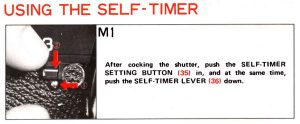
Reliability on these things is rather poor today as very few are found working. For all of the good things I can say about it’s looks and design, there still are some cost cutting measures such as the incredibly poorly designed self timer lever which is almost always found broken off. In fact, it’s so hard to find a picture of a dx-3 where the self timer level isn’t broken off, that I had to consult the dx-3 owners manual to find a picture of it.
The electronics of the dx-3 are also prone to failure. Whether this is a result of Miranda’s lack of experience in electronic cameras, or the materials used to make them, the rate of failure on the dx-3 is much higher than that of other 70s electronic SLRs. The electronics on the camera reviewed here were it’s main issue, despite the camera being in very nice physical condition.
I really wanted this camera to work. Maybe even more so than other Mirandas in my collection. It’s pretty, the viewfinder is super cool, and I just have this completely illogical fondness for the brand. I guess I’m a sucker for an underdog story, but alas, it was not meant to be. This Miranda dx-3, like the company who made it, is dead. Based on it’s nice physical condition, it likely wasn’t used much throughout it’s life, which is a shame, but you never know. I have a tendency to acquire working examples of dead cameras after posting one of these articles, so maybe one will come my way someday soon!
Edit (10/5/2020): I originally published this short review in the 5th Cameras of the Dead post in October 2018, and at that time, I had only access to this one Miranda dx-3. Since then, I came across an auction of not one, not two, but SEVEN Miranda dx-3s, all in their original box.
Score, I thought! I knew this camera had a poor reputation for reliability, but come on, seven cameras? One of them had to work, right?
Nope.

Literally, all of them had issues. Four of them were completely inoperable. The film advance didn’t work and I couldn’t fire the shutter, even with fresh batteries. Of the three that would fire, one, the curtains would never separate, no matter what speed I selected. The second would fire, but only at the same speed, and the metering and LCD display didn’t work.
The final one however, appeared to be OK. Not only did the shutter fire at every speed, but the red LCD display in the viewfinder worked fine! I was so excited, so I loaded in a 24 exposure roll of film and took it out shooting. When I got to the 24th exposure, I was excited to get a 25th shot. That means I was efficient at getting an extra shot on the leader. Then I got a 26th. Wow! Two extra shots I thought. I’m a film loading ninja!
But then I got a 27th, 28th, 29th… Knowing sure sure I hadn’t loaded in a 36 exposure roll, I started to rewind the film and could feel it immediately lose resistance as the leader came off the take up spool, as if it was still at the beginning of the roll.
Sure enough, after what I thought was 24+ exposures through my first working dx-3, I discovered this camera had a film advance problem. The thing is, with the back open and no film loaded, everything appeared to work correctly, but as soon as you put even the tiniest bit of resistance on the take up spool from film being attached to it, it no longer advance. All I was doing was shooting the same exposure over and over again. I played with it some more with some test film, making sure the camera wasn’t accidentally in rewind mode or something and nothing worked.
Back on the pile it went. Counting my original dx-3, that makes eight dead cameras.
Related Posts You Might Enjoy
External Links
http://camera-wiki.org/wiki/Miranda_dx-3
http://www.mirandacamera.com/_modelinfo/_dx-3/dx-3.htm
https://simonhawketts.co.uk/2017/03/23/miranda-dx-3-35mm-slr-camera/

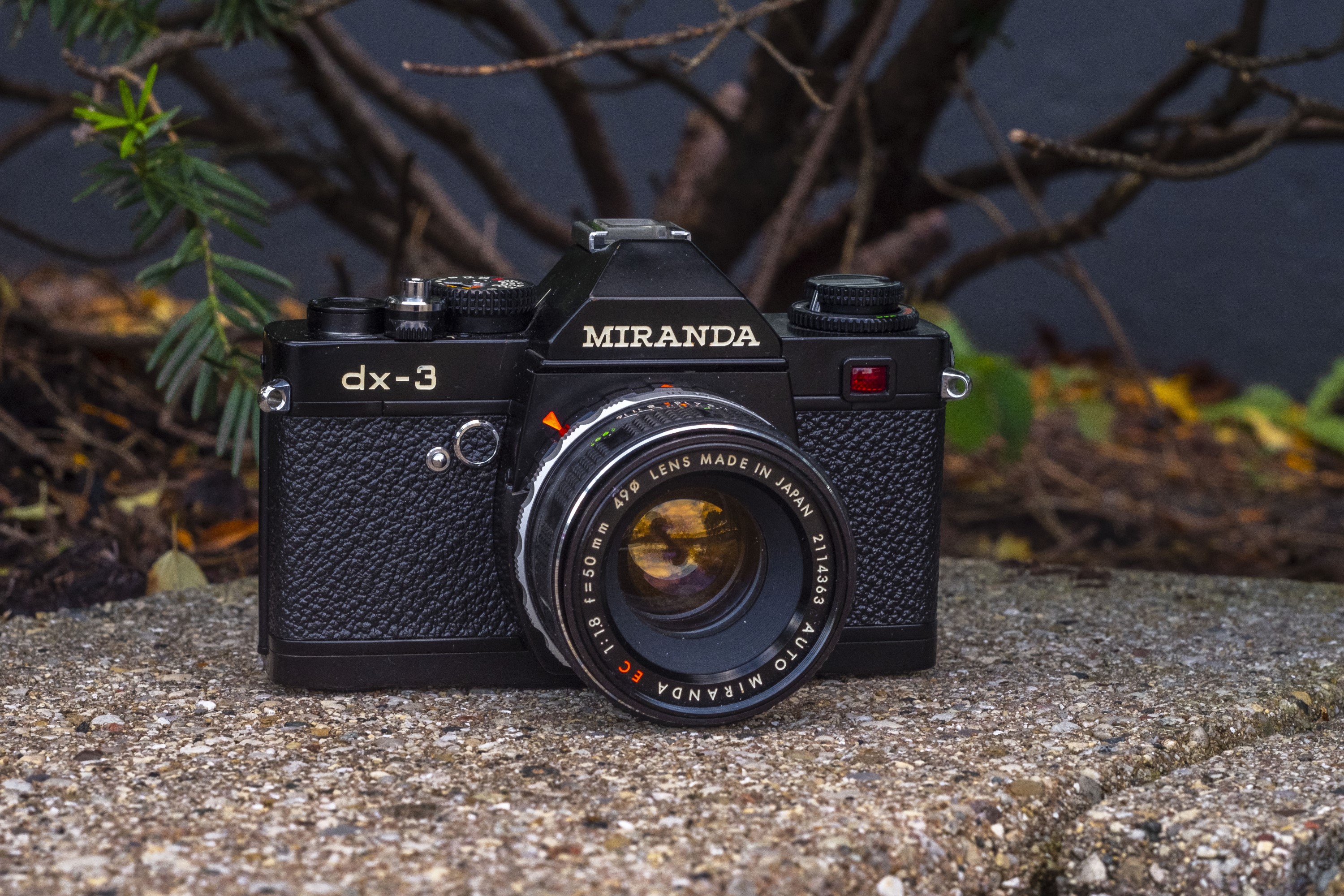

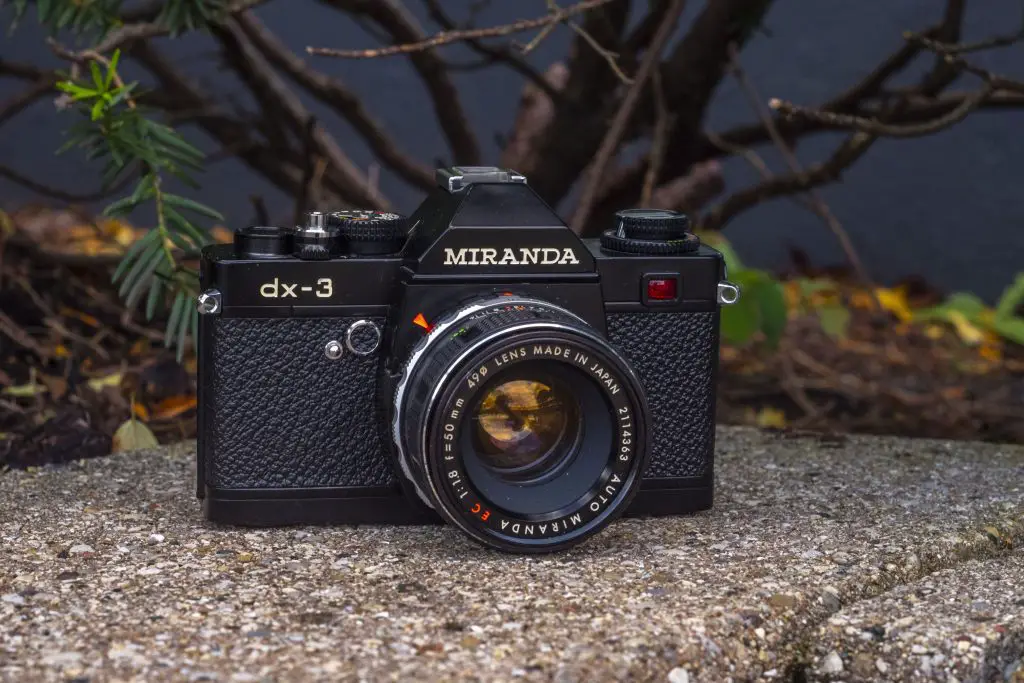
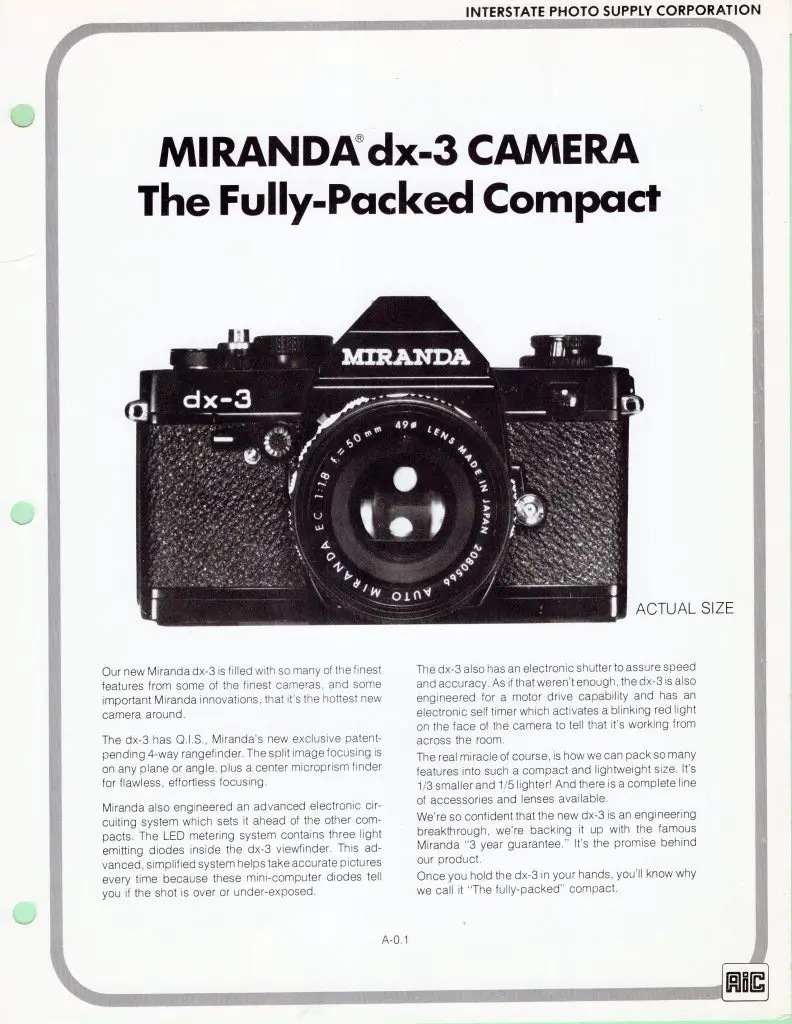
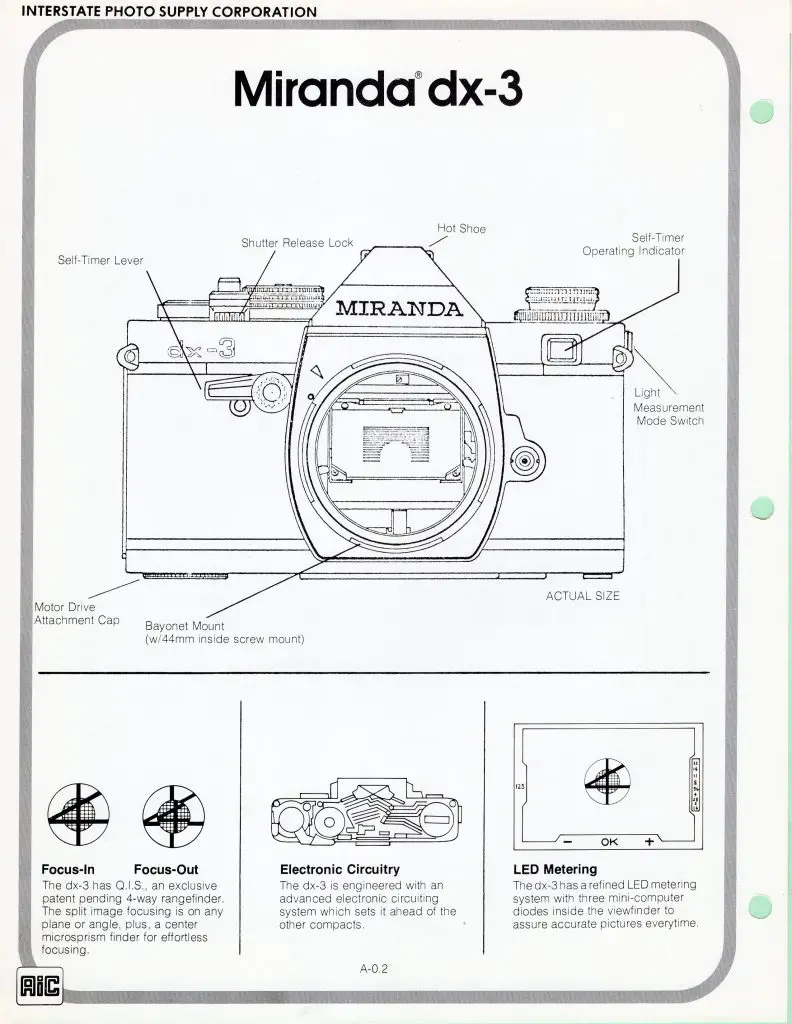
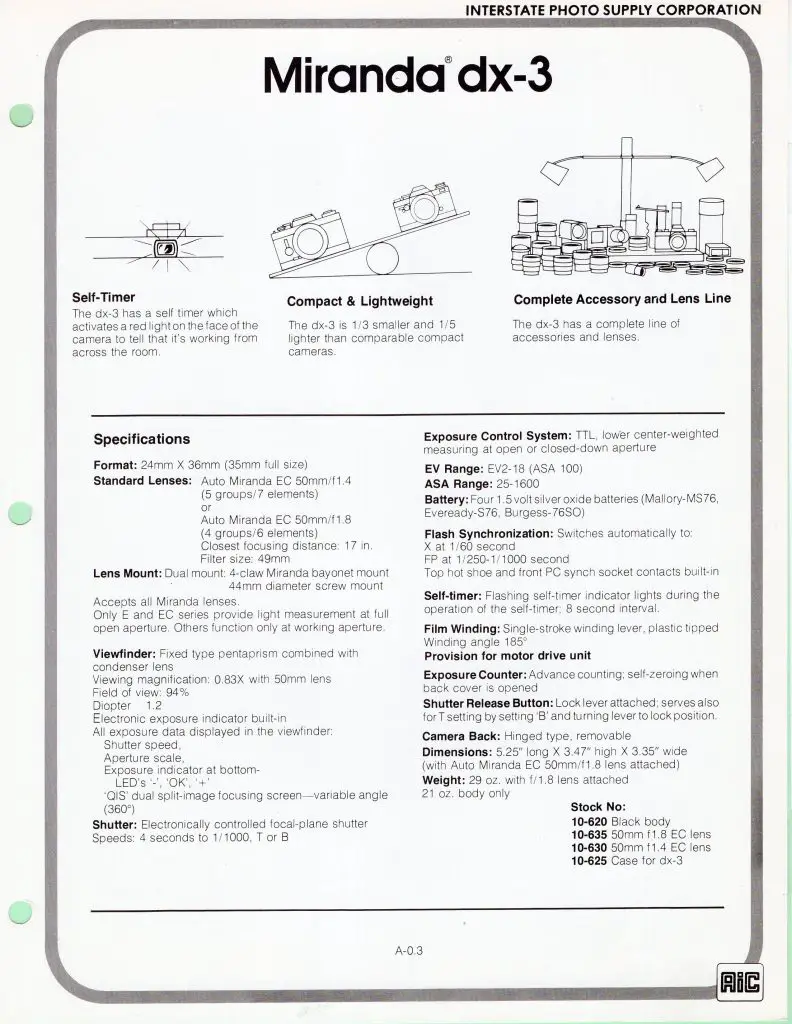






So grateful that I never even thought about buying the last Miranda..My cousin and I used a Miranda back in the day is it was a very good and capable camera
Talking about focusing systems. You can find extremely bright, split diagonal focusing systems on the Retina 3 slr and the praktica B series.
My Sensorex is still working well and I love using it. Got it CLA’d last year and hoping it will survive for a while yet.
Checking your other Miranda entries after reading that you were an “aficionado” during the Petri entry. Just wanted to say that back in the late 70’s, I worked at a place as a senior photographer in an advertising department: we manufactured cookware. My boss was a real advertising “conniver” , and was always involved in getting weird merchandise to use during giveaways and such. I was floored when he showed up with a case of Miranda dx-3’s and standard lenses one day! He got them for practically nothing, and when I say nothing, I mean like nothing. I managed to buy one with a standard lens to send my sister, who was a “light use” photographer, and I think I paid 35 bucks for the body and standard lens (and it was not “at cost” either, he made money)! As an x-Miranda aficionado myself, I was aware that the dx-3 was pretty undependable, so I never grabbed one for myself, my Mirandas were long gone by ’75. Too bad, I wonder if she still has it?
A question that I have always wanted to know: the DX-3 has automatic exposure?
It does not.
I bought my dx3 in 1976 from a mail order seller in Skokie Illinois, used it until about 1992 when it was burning through batteries too quickly, shutter was slowing down, much dust in the pentaprism, film advance was creating double exposures, corroded from being around salt water, light getting between the body and the lens. Eventually I beat it within an inch of its life on the old cracked concrete step leading up to the front door of a decrepid rental on Potter street in Eugene Oregon.
A question that I have never been able to answer: the DX-3 does have auto exposure?
The dx3 was the first SLR that I owned. I used it throughout high school as a photographer for the school yearbook in the late 70s early 80s. Never had an issue with it and replaced it with a Canon AE-1 since I wanted more lens choices.
I believe Cosina may have had a hand in the production of the DX-3. The Petri MF-2 and MF-3 (Cosina-made K-mount SLRs) use the same “+/-/OK” LED display in the viewfinder, so Cosina possibly supplied the metering electronics for the DX-3, if not other components as well.
It’s too bad the DX-3 wasn’t a more successful model, as it seemed thoughtfully designed, handled nicely, and looked good. They did seem to be heavy on batteries (the original case had a holder for 4 spare batteries). I have a number of Miranda SLRs and have come across many others, all of which have been in working condition, with the exception of the DX-3. In general, I have never felt that Miranda cameras were of poorer quality or less reliable than other Japanese brands.